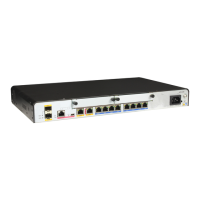Pre-configuration Tasks
Before configuring static LSPs, complete the following task:
l Configuring a static unicast route or an IGP to connect LSRs on the network layer
Data Preparation
To configure static LSPs, you need the following data.
No. Data
1 Name of the static LSP
2 Destination address and mask
3 Value of an incoming or outgoing label on each LSR
4 Next hop address or outgoing interface on the ingress
5 Incoming interface, next hop address, or outgoing interface on a transit node
6 Incoming interface on the egress
1.3.2 Configuring the LSR ID
Before enabling MPLS, configure the LSR ID.
Context
When configuring an LSR ID, note the following issues:
l The LSR ID must be configured before other MPLS commands are run.
l The LSR ID does not have a default value and must be configured manually.
l Using the address of the loopback interface of the LSR as the LSR ID is recommended.
l To modify the configured LSR ID, run the undo mpls command in the system view to
delete all the MPLS configurations.
Perform the following steps on each LSR in an MPLS domain:
Procedure
Step 1 Run:
system-view
The system view is displayed.
Step 2 Run:
mpls lsr-id lsr-id
The LSR ID of the local node is configured.
lsr-id: A number in dotted decimal notation that identifies an LSR.
----End
Huawei AR1200 Series Enterprise Routers
Configuration Guide - MPLS 1 Static LSPs Configuration
Issue 01 (2011-12-30) Huawei Proprietary and Confidential
Copyright © Huawei Technologies Co., Ltd.
3

